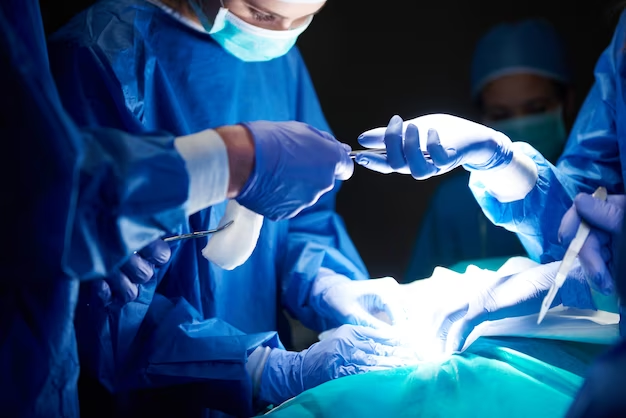Global Minimally Invasive Medical Devices Market Driven by Benefits of MIS Procedures
|
By HospiMedica International staff writers Posted on 31 Jul 2023 |

The global demand for minimally invasive surgical (MIS) devices is being driven by the many benefits MIS procedures offer, such as fewer serious surgical and post-surgical complications and faster recovery times. Coupled with a rising prevalence of chronic diseases, these factors are fuelling the growth of the global MIS devices market. As a result, the global market for minimally invasive medical devices which was valued at USD 26.4 billion in 2022 is projected to register a compound annual growth rate (CAGR) of 7.6% to reach USD 41 billion in 2028, driven by the increasing demand for MIS procedures which will be fueled by the growing burden of non-communicable diseases.
These are the latest findings of Research and Markets (Dublin, Ireland), a market research firm.
MIS procedures are typically viewed as less traumatic than traditional open surgeries, which use conventional laparoscopic tools, making them more complex. In MIS, minimally invasive laparoscopic cameras and specialized tools are introduced into the body via small incisions, leading to quicker recovery times and reduced pain for patients compared to other surgical methods. The significantly lower costs of MIS procedures, relative to in-patient and traditional open surgeries, without compromising on treatment outcomes, are one of the primary factors propelling the growth of the MIS devices market.
Technological advancements, particularly within cardiac, ophthalmic, neurological, orthopedic, and oral surgical procedures, leading to higher-quality instruments with superior efficiency, are set to further boost the MIS devices market. The emergence of surgical robots and their global adoption by surgeons will also contribute to market growth. Other key drivers of market growth include an aging population, increased awareness of the benefits of MIS over traditional open surgeries, a surge in healthcare spending, and growing demand for surgeries. Additionally, improved product design providing enhanced control and precision in the operating theater, coupled with increased public-private partnerships supporting research activities, will present substantial growth opportunities for market players during the forecast period.
Related Links:
Research and Markets
Latest Business News
- Expanded Collaboration to Transform OR Technology Through AI and Automation
- Becton Dickinson to Spin Out Biosciences and Diagnostic Solutions Business
- Boston Scientific Acquires Medical Device Company SoniVie
- 2026 World Hospital Congress to be Held in Seoul
- Teleflex to Acquire BIOTRONIK’s Vascular Intervention Business
- Philips and Mass General Brigham Collaborate on Improving Patient Care with Live AI-Powered Insights
- Arab Health 2025 Celebrates Landmark 50th Edition
- Boston Scientific Acquires Medical Device Company Intera Oncology
- MEDICA 2024 to Highlight Hot Topics of MedTech Industry
- Start-Ups To Once Again Play Starring Role at MEDICA 2024
- Boston Scientific to Acquire AFib Ablation Company Cortex
- Hologic Acquires Gynesonics to Strengthen Existing Gynecological Surgical Business
- Smith+Nephew and JointVue Partner on Ultrasound Preoperative Planning in Robotics-Assisted Surgery
- Stryker Completes Acquisition of NICO Corporation
- BD Completes Acquisition of Critical Care from Edwards Lifesciences
- ZOLL to Acquire Vyaire Medical’s Ventilator Business
Channels
Critical Care
view channel
Ingestible Smart Capsule for Chemical Sensing in the Gut Moves Closer to Market
Intestinal gases are associated with several health conditions, including colon cancer, irritable bowel syndrome, and inflammatory bowel disease, and they have the potential to serve as crucial biomarkers... Read moreNovel Cannula Delivery System Enables Targeted Delivery of Imaging Agents and Drugs
Multiphoton microscopy has become an invaluable tool in neuroscience, allowing researchers to observe brain activity in real time with high-resolution imaging. A crucial aspect of many multiphoton microscopy... Read more
Novel Intrabronchial Method Delivers Cell Therapies in Critically Ill Patients on External Lung Support
Until now, administering cell therapies to patients on extracorporeal membrane oxygenation (ECMO)—a life-support system typically used for severe lung failure—has been nearly impossible.... Read moreSurgical Techniques
view channel
Intravascular Imaging for Guiding Stent Implantation Ensures Safer Stenting Procedures
Patients diagnosed with coronary artery disease, which is caused by plaque accumulation within the arteries leading to chest pain, shortness of breath, and potential heart attacks, frequently undergo percutaneous... Read more
World's First AI Surgical Guidance Platform Allows Surgeons to Measure Success in Real-Time
Surgeons have always faced challenges in measuring their progress toward surgical goals during procedures. Traditionally, obtaining measurements required stepping out of the sterile environment to perform... Read morePatient Care
view channel
Portable Biosensor Platform to Reduce Hospital-Acquired Infections
Approximately 4 million patients in the European Union acquire healthcare-associated infections (HAIs) or nosocomial infections each year, with around 37,000 deaths directly resulting from these infections,... Read moreFirst-Of-Its-Kind Portable Germicidal Light Technology Disinfects High-Touch Clinical Surfaces in Seconds
Reducing healthcare-acquired infections (HAIs) remains a pressing issue within global healthcare systems. In the United States alone, 1.7 million patients contract HAIs annually, leading to approximately... Read more
Surgical Capacity Optimization Solution Helps Hospitals Boost OR Utilization
An innovative solution has the capability to transform surgical capacity utilization by targeting the root cause of surgical block time inefficiencies. Fujitsu Limited’s (Tokyo, Japan) Surgical Capacity... Read more
Game-Changing Innovation in Surgical Instrument Sterilization Significantly Improves OR Throughput
A groundbreaking innovation enables hospitals to significantly improve instrument processing time and throughput in operating rooms (ORs) and sterile processing departments. Turbett Surgical, Inc.... Read moreHealth IT
view channel
Printable Molecule-Selective Nanoparticles Enable Mass Production of Wearable Biosensors
The future of medicine is likely to focus on the personalization of healthcare—understanding exactly what an individual requires and delivering the appropriate combination of nutrients, metabolites, and... Read more
















